Savoring St. Martin
Many come for the sun, sand, and surf but stay for the exceptional French and Creole cuisine
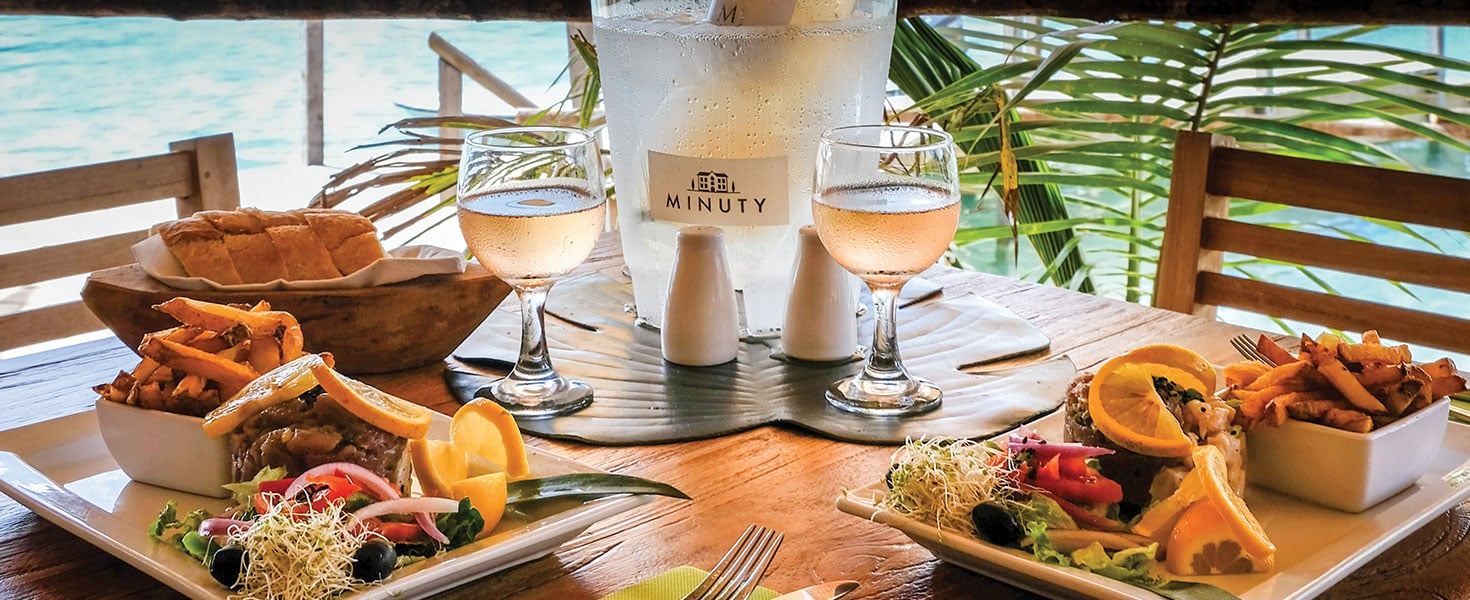
It’s about noon on a Saturday and tables at La Terrasse already are filling up quickly. This rooftop restaurant with outdoor and indoor spaces overlooks the ocean and the bustling center of Marigot, the capital of the Caribbean island of French St. Martin. Owner Dylan Wagner, a transplant from Southeast France, serves me a classic French dish: slow-roasted duck, garlic butter snails and egg cocotte baked to liquid perfection with mushrooms and bacon chips, topped with colorful fresh peppers.
“It’s my grandmother’s recipe,” Wagner says. “It’s simple and delicious, and it’s our number-one appetizer. Everyone asks for it. You must serve it with fresh bread—or it doesn’t taste quite the same."
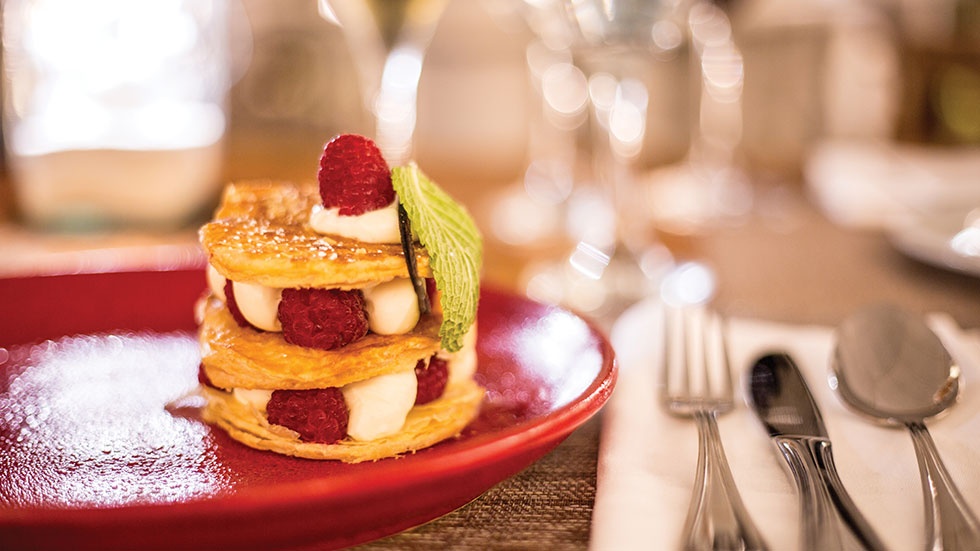
Mille-Feuille aux Framboises at L’Astrolabe. Photo credit photo Donovane Tremor
RELISHING FRENCH FARE
Slurping egg cocotte at La Terrasse is like having a bistro brunch on the beach. It’s a fitting description because many French chefs brought—and continue to bring—their epicurean talents to the tropics. The island, the southern half of which is Dutch and the northern French (although there are no customs or border stops), is called the Culinary Capital of the Caribbean for good reason. A melting pot of more than 120 nationalities, St. Martin seamlessly blends the best of many nations. Many travelers come here for the island atmosphere—and then settle permanently. There’s another reason, too: the island’s “strategic” location. Although seemingly far away from any European or American epicurean hubs, it’s close enough to take advantage of the best ingredients both continents have to offer.
“It takes seven hours to deliver food orders from Paris to Southeast France by truck,” says Wagner. “It takes the same seven hours to deliver our orders by plane. I can order French butter, cheese and duck, and it all will be here the next day.”
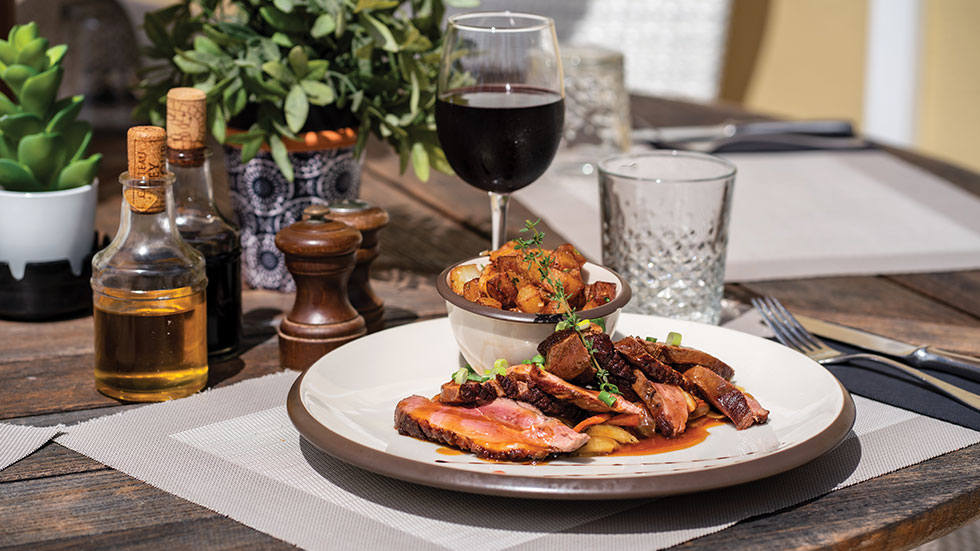
La Terresse’s slow-roasted duck with crispy potatoes. Photo By Clément Louineau
Delivery of the best beef from American pastures and the cold-water seafood from Canadian shores takes even less time. Add to that tropical fruit, fresh spices and the island’s own Caribbean Creole-style of cooking with local seafood, rice, peas and plantains—and you have a perfect recipe for gastronomic excellence.
Thomas Moreau, who owns L’Astrolabe—a restaurant at Esmeralda Resort, where gourmet dinners are served by the pool or in a tropical garden—came here more than two decades ago, fell in love with the island and never left. “Our secret is the mix of traditional French cuisine and Caribbean ingredients,” Moreau says. That happy marriage is perhaps most pronounced in his lobster bisque served with duck liver ravioli. “I’ve had this soup on the menu for about 20 years, and people still ask for it,” he says. “Once or twice, I tried to take it off the menu, just to do something different, but everyone wanted it, so we put it back.”
Moreau attributes St. Martin’s culinary distinction to the island’s local fruits and vegetables as well. “We grow terrific tomatoes here in winter when it’s not too hot. And our pineapples and mangos make terrific desserts,” he adds. Speaking of desserts, L’Astrolabe’s Mille-Feuille aux Framboises (raspberry Napoleon) is a cinematic masterpiece. A miniature tower of several layers of buttery puff pastry propped up by rows of impeccable red-pink berries elbowing dollops of white chocolate and mascarpone cream, it’s worthy of not only a photo but also a late-night trip.
Pauline Giraud, manager of Maison Mère—one of the island’s newer additions, where gourmet plates are served as gentle breezes from the nearby ocean flow through the room—recommends slow-roasted lamb, beef cheeks or red snapper quenelle, a specialty from the city of Lyon, France, and, she says, something you won’t find anywhere else on the island. If you choose the popular baked Dover sole, have your camera ready when the pan arrives—as your waiter will debone the fish with a jeweler’s precision while you look on.
For more dinnertime spectacles, swing by L’Auberge Gourmande, where owner Pascal Narme recommends onion soup and quail stuffed with foie gras. Afterward, opt for a flambé dessert in which a cup of brandy is set afire and poured over sliced fruit and ice cream.
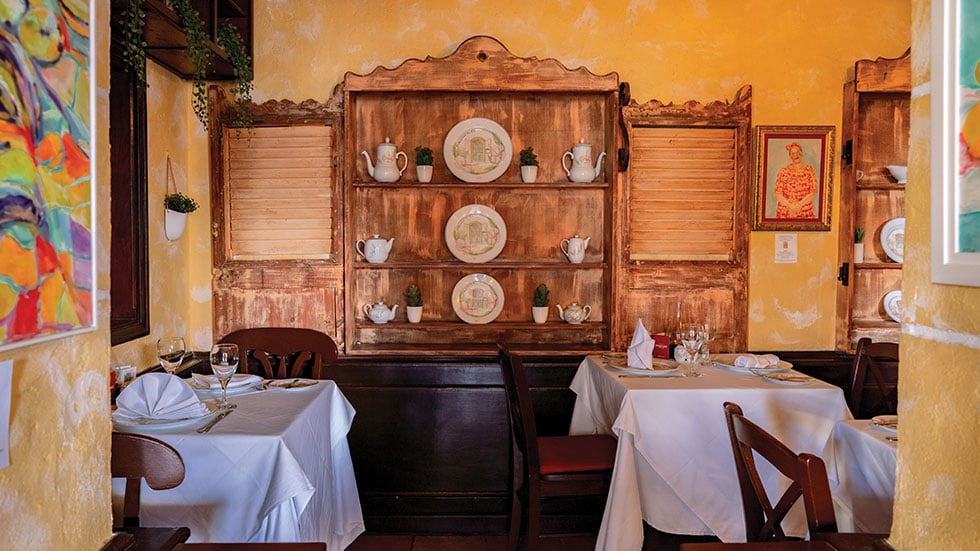 A meal at L’Auberge Gourmande tastes and looks like Paris. Photo by Clément Louineau
A meal at L’Auberge Gourmande tastes and looks like Paris. Photo by Clément Louineau
CURATING CARIBBEAN SPECIALTIES
That’s not to say that every St. Martin cook dishes out only French fare. Many local chefs serve traditional Caribbean plates, culled from generations-old family recipes. Chef Jewel Daal grew up cooking alongside her mother, who made dinners for large family gatherings and other events and eventually opened a restaurant.
“My mother was a person of tradition and heritage,” says Daal. “She wanted to bring forward our culture and our food and share it with others.” Following in her mother’s footsteps, Daal opened TJ’s Cassava Coal Pot—in tribute to the staple cassava root vegetable and the local style of cooking on hot coals. Its menu includes specialty island treats for adventurous foodies, such as savory soups made from pig and cow feet.
“When it comes to the dishes I cook, I think I am even more traditional than my mother,” she says. “I am really one hundred percent about our local cuisine.”
Those hungry for other traditional favorites can find them at lolos, local outdoor eateries, many of which are in Marigot’s center. Overlooking the sea, these breezy, colorful spots entice visitors to try something new, such as the island’s traditional breakfast of salted fish with Creole spices, cod fritters and johnnycakes (finger-licking fried breads with a variety of savory fillings such as cheese, ham and egg). No one knows exactly where the name “johnnycake” came from, but this beloved breakfast of fishermen and laborers transformed into the island’s iconic morning grab.
As you browse the lolos, swing by Hot Spot by Bush Tea Sxm, a bar where mixologist Daryl Brooks creates tasty drinks inspired by the island’s scents and spices. His signature tamarind martini—infused with the staple sweet-and-sour island spice—won first prize at St. Martin’s inaugural Festival de la Gastronomie Saint-Martin in 2021.

At the café, delightful dishes arrive to the rhythms of the sea. Photo By Clément Louineau
DINING WITH A DIFFERENCE
Beachfront restaurants on St. Martin are worth the effort to make a reservation. At the Rainbow Café, sushi rolls topped with mouthwatering foie gras morsels arrive to the staccato sound of ocean waves in the background. At Coco Beach, lunch is served at cocktail tables nestled in sand dunes. Shoes and shirts are optional here—you can go for a swim while waiting for your cocktail—but the relaxed setting won’t diminish the flavors. The roasted rack of lamb and the passionfruit dessert will be just as unforgettable as in any AAA Diamond-rated restaurant.
Some chefs manage to push the boundaries even in this competitive environment. Chef Bastian Schenk, who owns La Villa Hibiscus—a six-room guesthouse with a restaurant—offers a tasting menu with a twist. “We ask our guests about their dietary preferences, about their allergies and what they like to eat, and then we surprise them,” he says. Our guests don’t know what’s coming, so they ‘discover’ every dish.”
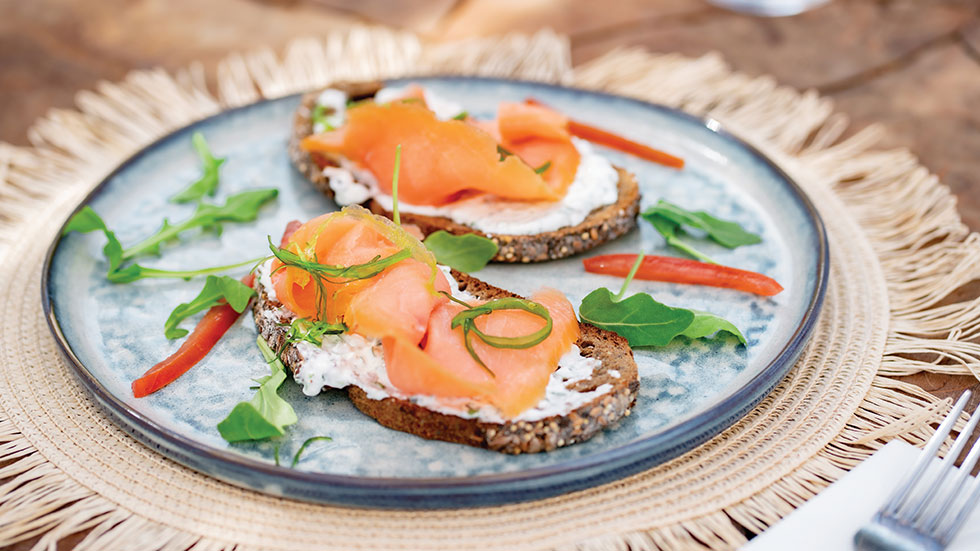
A breakfast plate of Norwegian toast at the Rainbow Café beckons with tender home-smoked salmon and cottage cheese. Photo By Clément Louineau
Schenk’s designs aren’t only delicious; they also look like edible art, each dish meticulously assembled to look like a rose, a carnation or an abstract painting. The scallop salad, for example, arrives inside a seashell, and the tender Wagyu steak masquerades as a flower sprouting from spring greens. Schenk pays special attention to the fragrance of the food, awakening the olfactory sense to enrich the flavor. That’s why some dishes arrive covered with a transparent lid to preserve the smoky aroma.
Originally from Belgium, Schenk worked in some of the finest restaurants in Europe before he decided to put down roots in St. Martin and launch his discovery dining idea. He is happy to let guests watch the preparation in his partially open kitchen. Guests can help, too. “Sometimes, when it’s not too busy, we invite people into the kitchen to work with us,” Schenk says. “We love showing them a little bit of the magic.”
And magic it is. The island’s culinary scene is guaranteed to tease and please even the most discerning gourmand’s taste buds. So, pack light but come with a hungry desire to eat your way through this paradise of deliciousness. Bon appétit!
